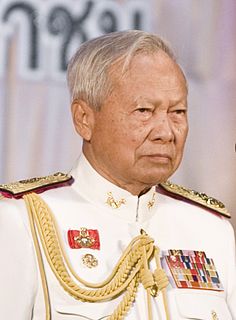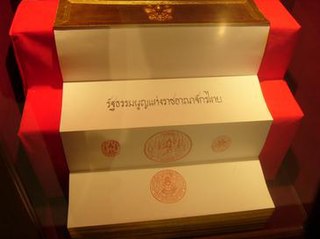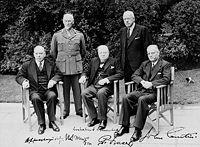
The Governor-General of the Commonwealth of Australia is the representative of the Australian monarch, currently Queen Elizabeth II. As the Queen is concurrently the monarch of 15 other Commonwealth realms, and resides in the United Kingdom, she, on the advice of her Australian prime minister, appoints a governor-general to carry out constitutional duties within the Commonwealth of Australia. The governor-general has formal presidency over the Federal Executive Council and is commander-in-chief of the Australian Defence Force. The functions of the governor-general include appointing ministers, judges, and ambassadors; giving royal assent to legislation passed by parliament; issuing writs for election; and bestowing Australian honours.

A prime minister is the head of a cabinet and the leader of the ministers in the executive branch of government, often in a parliamentary or semi-presidential system. A prime minister is not the head of state of their respective state nor a monarch, rather they are the head of government, serving typically under a monarch in a hybrid of aristocratic and democratic government forms or a president in a republican form of government.

The prime minister of Japan is the head of government of Japan and the commander-in-chief of the Japanese Armed Forces. The prime minister is appointed by the Emperor of Japan after being designated by the National Diet and must enjoy the confidence of the House of Representatives to remain in office. He is the head of the Cabinet and appoints and dismisses the other ministers of state. The literal translation of the Japanese name for the office is Minister for the Comprehensive Administration of the Cabinet.

Until 22 May 2014, the politics of Thailand were conducted within the framework of a constitutional monarchy, whereby the prime minister is the head of government and a hereditary monarch is head of state. The judiciary is independent of the executive and the legislative branches.

The Prime Minister of Spain, officially the President of the Government of Spain, is the head of the government of Spain. The office was established in its current form by the Constitution of 1978 and originated in 1823 as a chairmanship of the extant Council of Ministers.

A commander-in-chief or supreme commander is the person who exercises supreme command and control over an armed forces or a military branch. As a technical term, it refers to military competencies that reside in a country's executive leadership, a head of state or a head of government.

The prime minister of Thailand is the head of government of Thailand. The prime minister is also the chair of the Cabinet of Thailand. The post has existed since the Revolution of 1932, when the country became a constitutional monarchy.

The Prime Minister of the Netherlands is the head of the executive branch of the Government of the Netherlands in his capacity as chair of the Council of Ministers. The Prime Minister is de facto the head of government of the Netherlands and coordinates its policy with his cabinet. The current Dutch Prime Minister is Mark Rutte, in office since 2010.

Prem Tinsulanonda was a Thai military officer, politician, and statesman who served as the Prime Minister of Thailand from 3 March 1980 to 4 August 1988, during which time he was credited with ending a communist insurgency and presiding over accelerating economic growth. As president of the Privy Council, he served as Regent of Thailand from the death of King Bhumibol Adulyadej on 13 October 2016, until the 1 December 2016 proclamation of Vajiralongkorn as King. At the age of 98, Prem was the longest-living Thai Prime Minister.

The Prime Minister of the Kingdom of Cambodia is the head of government of Cambodia. The prime minister is also the chairman of the Cabinet and leads the executive branch of the Royal Cambodian Government. The prime minister is a member of parliament, and is appointed by the monarch for a term of five years. Since 1945, 36 individuals have served as prime minister; 32 as official prime ministers, and 4 in acting capacities.

The House of Representatives is the lower house of the National Assembly of Thailand, the legislative branch of the Thai government. The system of government of Thailand is that of a constitutional monarchy and a parliamentary democracy. The system of the Thai legislative branch is modelled after the Westminster system. The House of Representatives has 500 members, all of which are democratically elected: 375 members were directly elected through single constituency elections, while the other 125 are elected through party-list proportional representation. The roles and powers of the House of Representatives were enshrined in the Constitution of 2017.

The Governor-General of New Zealand is the viceregal representative of the monarch of New Zealand, currently Queen Elizabeth II. As the Queen is concurrently the monarch of 15 other Commonwealth realms, and lives in the United Kingdom, she, on the advice of her New Zealand prime minister, appoints a governor-general to carry out her constitutional and ceremonial duties within the Realm of New Zealand.

The Constitution of the Kingdom of Thailand provides the basis for the rule of law in Thailand.

The Constitution of the Kingdom of Thailand, Buddhist Era 2550 (2007) was the constitution of Thailand which was in effect from 2007 to 2014.

The National Assembly of Thailand is the bicameral legislative branch of the government of Thailand. It convenes in the Sappaya-Sapasathan, Dusit District, Bangkok.

The Government of Thailand, or formally the Royal Thai Government, is the unitary government of the Kingdom of Thailand. The country emerged as a modern nation state after the foundation of the Chakri Dynasty and the city of Bangkok in 1782. The Revolution of 1932 brought an end to absolute monarchy and replaced it with a constitutional monarchy.

Yingluck Shinawatra, nicknamed Pou, is a Thai businesswoman, politician and a member of the Pheu Thai Party who became the Prime Minister of Thailand following the 2011 election. Yingluck was Thailand's first female Prime Minister and its youngest in over 60 years. She was removed from office on 7 May 2014 by a Constitutional Court decision.

Prayut Chan-o-cha is a Thai politician, retired Royal Thai Army general officer and former leader of the National Council for Peace and Order (NCPO), the military junta which governed Thailand between 22 May 2014 and 10 July 2019. As of August 2019 he serves as Prime Minister of Thailand, Thailand's Defence Minister, and head of the Royal Thai Police. In addition, he assumed the duties of Deputy Prime Minister Somkid Jatusripitak as head of the government's economic team and oversees the Justice Ministry's Department of Special Investigation (DSI).
The National Council for Peace and Order was the military junta that ruled Thailand between its 2014 Thai coup d'état on 22 May 2014 and 10 July 2019. On 20 May 2014, the military declared martial law nationwide in an attempt to stop the country's escalating political crisis, and to force the democratically elected government out of office. On 22 May, the military removed the Yingluck Shinawatra government and formed the NCPO to take control of the country. The junta censored the broadcasting system in Thailand, suspended the constitution, and detained members of the Thai cabinet. The NCPO was formally dissolved following the swearing-in of the new cabinet on 16 July 2019. Critics like former Thai ambassador Pithaya Pookaman charge that the NCPO "...is practically still very much intact. Its arbitrary power[s] ... transferred to the existing Internal Security Operations Command chaired by the prime minister."
The Constitution of the Kingdom of Thailand (Interim) 2014 was a constitution of Thailand in force between 2014–17.


























































